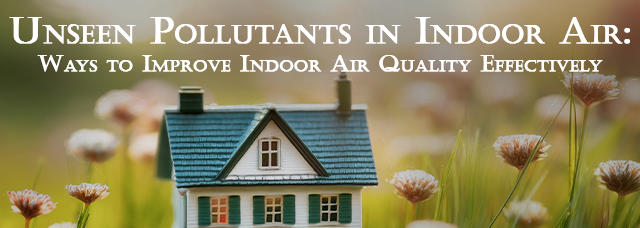Indoor Air Pollution: Recognize Hidden Hazards and Improve Your Living Space

When we think of pollution, we often picture smog-filled skies or industrial emissions. However, the air we breathe indoors can be just as polluted, if not more so. Indoor air pollution can have a significant impact on our health, causing a range of symptoms from headaches and fatigue to respiratory problems and allergies. Understanding the sources and solutions is key to improving indoor air quality and protecting our health.
Common Sources of Indoor Air Pollution
- Household Chemicals: Everyday products like cleaning agents, paints, and air fresheners release volatile organic compounds (VOCs) into the air. These chemicals can cause headaches, dizziness, or long-term respiratory issues.
- Mould and Mildew: High humidity levels can lead to the growth of mould and mildew, which release spores into the air, potentially causing allergic reactions or respiratory problems.
- Pet Dander and Dust Mites: Homes with pets or poor ventilation can accumulate allergens like pet dander and dust mites, which can aggravate asthma and other respiratory conditions.
- Carbon Monoxide and Radon: Inadequate ventilation, poorly maintained appliances, and certain building materials can expose occupants to dangerous gases like carbon monoxide and radon, both of which are odorless but highly toxic.
- Second-hand Smoke: Tobacco smoke contains hundreds of harmful chemicals and poses risks even to non-smokers through second-hand exposure.
Health Impacts of Poor Indoor Air Quality
Prolonged exposure to indoor air pollutants can lead to various health issues, such as:
- Respiratory problems (asthma, bronchitis)
- Headaches and dizziness
- Fatigue and irritability
- Allergic reactions
- Long-term exposure may even increase the risk of more serious conditions like lung disease or heart problems.
How to Improve
These are specialists for flammable liquids (Class B) and some Class C fires. They contain a smothering agent that disrupts the fire triangle (fuel, oxygen, heat).
Proper Use:
- Improve Ventilation: Make sure your home or office is well-ventilated by opening windows and using fans to circulate air. Consider installing air purifiers with HEPA filters (High-Efficiency Particulate Air filter) to remove airborne particles.
- Control Humidity: Use dehumidifiers to maintain indoor humidity levels below 50%. This can help prevent the growth of mould and mildew.
- Use Natural Cleaning Products: Opt for eco-friendly, non-toxic cleaning products to reduce the release of harmful chemicals. Avoid air fresheners and instead use natural alternatives like essential oils.
- Maintain Appliances: Regularly check and maintain appliances like stoves, heaters, and air conditioners to ensure they are functioning properly and not emitting harmful gases.
- Keep Your Space Clean: Regular cleaning and dusting can reduce allergens like dust mites and pet dander. Use a vacuum with a HEPA filter to trap particles that would otherwise remain in the air.
Conclusion
While often overlooked, indoor air pollution poses real health risks that we should all be aware of. By taking simple steps like improving ventilation, using safer products, and maintaining appliances, we can significantly improve the quality of the air we breathe indoors and safeguard our health.
Ready to improve your indoor air quality? We offer air testing services with NABL accredited lab facilities to ensure accurate and reliable results for your indoor air quality needs. Know more
